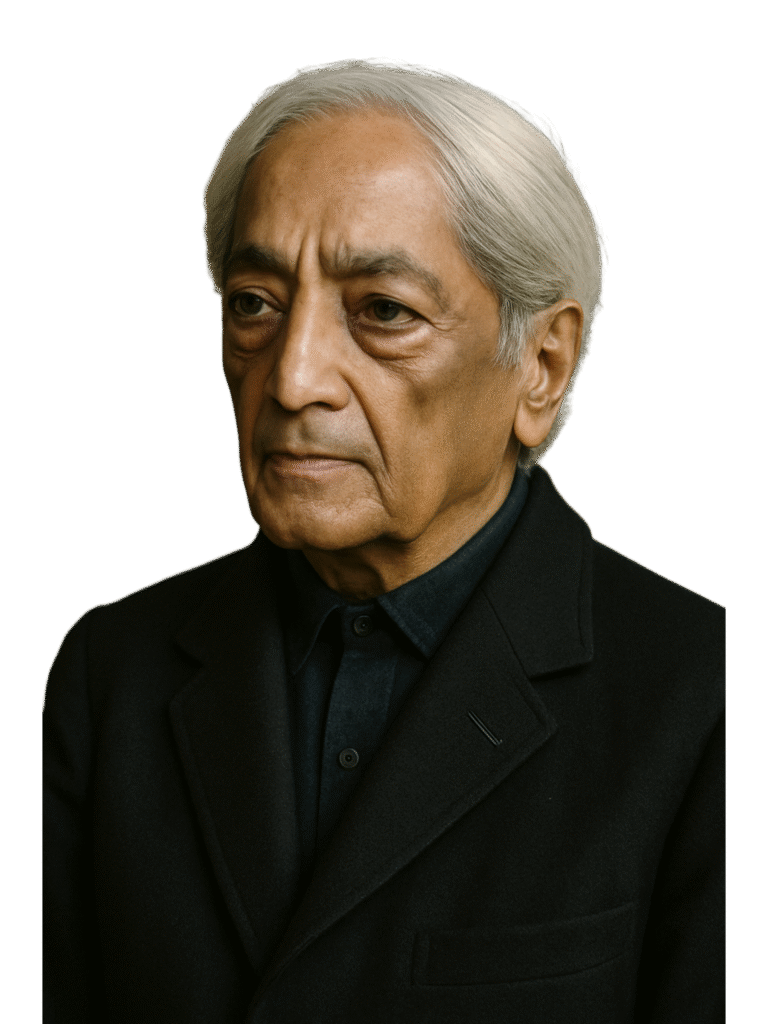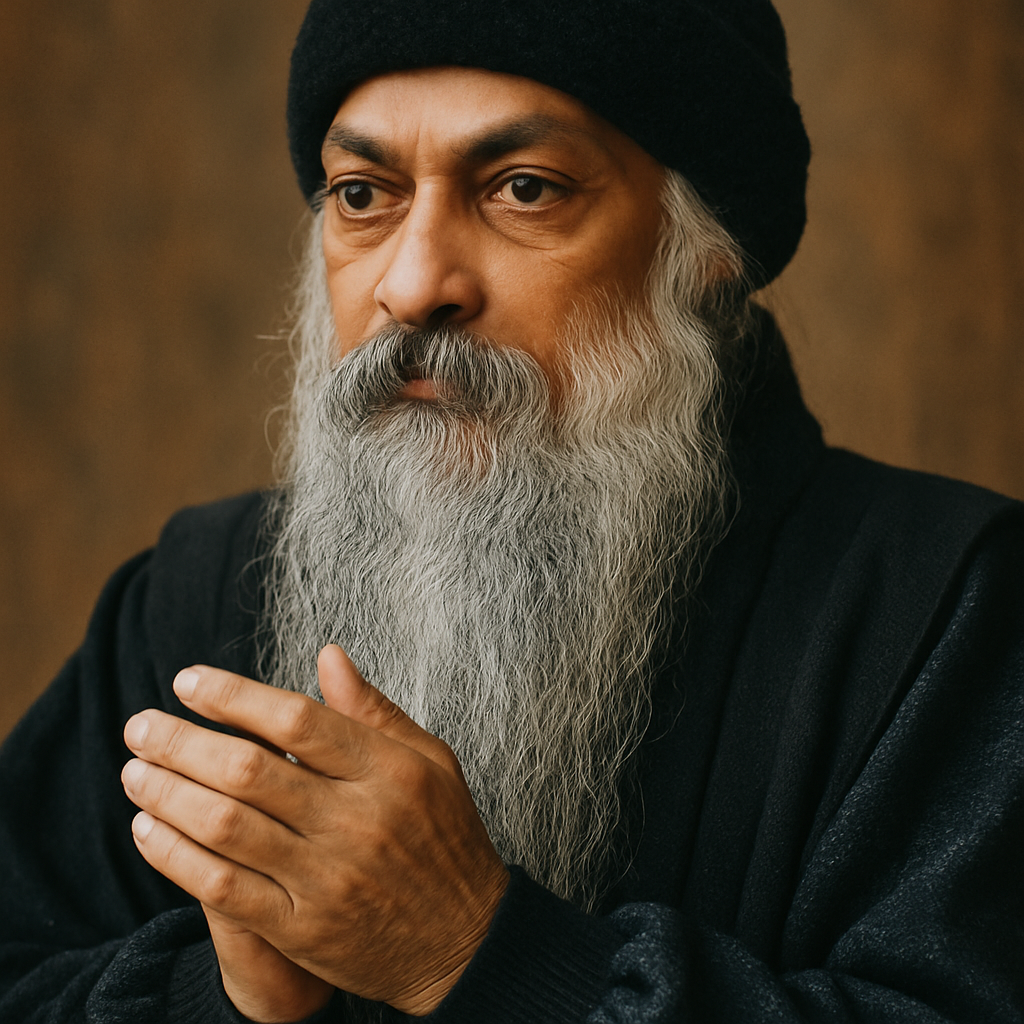

Jiddu Krishnamurti
Jiddu Krishnamurti (1895–1986) was a thinker and speaker who invited people to look at mind, thought and freedom directly — without reliance on authority, tradition, or fixed systems. Rather than creating a school of belief, he emphasised self-inquiry, choiceless awareness, and the ending of psychological dependence on the past.
Key themes of his teaching:
- Freedom from the known: Seeing how the past structures perception so the mind can meet life freshly.
- Choiceless awareness: Observing thought without judgement or the desire to change it.
- Responsibility without blame: Observing the psychological roots of conflict and acting from clarity rather than reaction.
His style was direct and uncompromising: not to give answers, but to encourage a deep, personal investigation that dissolves the patterns which create suffering. Krishnamurti travelled widely, giving talks and dialogues that continue to inspire seekers, educators, and thinkers worldwide.


Osho (Bhagwan Shree Rajneesh)
Osho was a spiritual teacher known for blending ancient Eastern wisdom with modern approaches to meditation and living. He taught a joyful, direct path to awareness — encouraging people to meditate, celebrate life, and drop social conditioning. His methods emphasised personal experience over dogma and invited radical honesty and presence.
Core aspects of Osho's message:
- Meditation as transformation: Practical techniques (including Dynamic Meditation) to release tensions and reach silence.
- Living totally: Integrating love, laughter, and awareness into everyday life rather than postponing freedom.
- Questioning authority: Encouraging individual inquiry instead of accepting inherited beliefs.
- Celebration & creativity: Seeing existence as sacred through play, art, and celebration.
Osho's talks and methods are polarizing: loved by many for their freshness and practicality, criticised by some for controversy around his communities and public life. Regardless, his practical insistence on direct experience and meditation continues to influence meditation teachers, seekers, and those searching for an unconditioned life.
Mind & Wisdom
Explorations in thought — essays inspired by Osho & J. Krishnamurti
What is the Mind? — Insights from Osho and J. Krishnamurti
A clear, compassionate guide to how the mind works, how memory builds the "me", and simple ways to observe and live beyond thought.
The mind is at once the most familiar friend and the deepest mystery. Below, we walk through practical examples and essential teachings from Osho and Krishnamurti to feel, understand, and possibly transform the relationship you have with your own thinking.
What is the Mind?
The mind is not a physical thing that you can touch or see; it is a movement of thoughts, memories, and ideas. It is like a river that is never still, always flowing with images from the past and hopes for the future. The mind is built from what you have experienced, learned, and absorbed from the world. From the moment you were born, every word you heard, every image you saw, every feeling you experienced has been stored like a library inside you. This library does not just keep knowledge; it also keeps pain, fear, joy, and desire.
Osho said the mind is like a servant who has become the master—something that was meant to help you live has now started controlling your life. Krishnamurti said the mind is the past, always operating in the shadows of memory. In simple words, your mind is not fresh; it is old because it is made of yesterday.
The Mind as Memory
If you look closely, you will see that every thought you have is either a reaction from the past or a projection into the future. You see a person and instantly remember how they behaved before; this memory shapes your reaction. For example, if a dog once bit you, your mind will always warn you when you see any dog, even a friendly one. This is not because the dog in front of you is dangerous, but because the memory in your mind is still alive.
This is how the mind works—it constantly compares the present with the past and makes decisions based on old images. This habit keeps us safe in some situations, but it also limits us. Many people do not try new things because their mind says, “Remember last time you failed.” In this way, memory becomes a prison. Krishnamurti often said that as long as you are acting from memory, you are not truly free because you are repeating the old.
Mind as a Tool — and a Trap
The mind is a very useful tool when you need to solve practical problems. If you need to repair your car, cook a meal, or plan a journey, the mind’s memory and logic are necessary. Without it, you would not survive even for a day. But the problem begins when we start using the mind in areas where it cannot help—like love, relationships, self-worth, or the meaning of life.
Imagine you are looking at a sunset. If your mind is busy describing it—“This is beautiful, I saw a similar one in Goa last year”—you are not actually seeing it; you are comparing it to old images. In love, if you keep comparing your partner to your past relationships, you will never meet them fresh; you will only meet them through your old memories.
Osho: "The mind is a wonderful servant but a terrible master." Use it — do not be used by it.
The Mind Creates the “Me”
One of the deepest insights from both Osho and Krishnamurti is that the mind is the creator of the “me,” the sense of personal identity. You think you are this name, this job, this history because the mind has collected these labels over years.
Slowly, these opinions and memories become the “self” you believe you are. But if you watch carefully, you will see that this “me” is nothing more than a collection of thoughts, just like a story being told in your head. The story changes depending on what the mind remembers or imagines, but you believe it to be real.
Mind and Fear
Fear is one of the clearest examples of how the mind operates. Most fears are not about something happening now; they are about what might happen in the future or what has happened in the past. You may fear losing your job, not because you are losing it now, but because your mind imagines a future without money.
Krishnamurti used to say that when you see the structure of fear—that it is a thought projecting an image—you are already free from much of it. A practical example: if you notice that your fear of public speaking comes from one embarrassing moment in school, you may realise that the moment is over, but the mind keeps replaying it. Once you see this clearly, the fear loses much of its power.
Mind and Desire
Desire is another powerful movement of the mind. You see a new phone, and the mind instantly creates an image of yourself using it. This image is so attractive that you feel incomplete without it. The same happens with relationships, success, or social status—the mind projects a future image, and you start chasing it.
Osho said the mind lives in a cycle of wanting, getting, and wanting again. The mind is never satisfied because it survives on desire. Seeing this mechanism clearly is the first step to being free from endless wanting.
The Mind Cannot Know Truth
The mind cannot know truth, love, or beauty directly—it can only create ideas about them. If you have never tasted a mango, someone can describe it to you, but the description is not the taste. Similarly, the mind can imagine truth or love, but the imagination is not the reality.
You cannot think your way into love; you have to experience it directly by being present with someone, without the interference of the mind’s comparisons or judgments. You cannot think your way into freedom; you have to see the prison of the mind in action, and in that seeing, there is already a release.
Observing the Mind
Both Osho and Krishnamurti emphasised that the way to understand the mind is not by controlling it but by observing it. Trying to control the mind is like trying to make a river flow straight; you only create more tension. Observation is different—it is a silent watching, without judgment.
A practical exercise: spend five minutes every day sitting quietly and watching your thoughts as if they were clouds passing in the sky. Do not try to stop them; just notice them. This simple act of watching can bring deep clarity.
Living Beyond the Mind — Conclusion
Living beyond the mind does not mean destroying memory or forgetting your life. It means learning when to use the mind and when to let it rest. Be fully present when you work, completely present when you love, and simply present when you walk. Meet each moment as if it were the first time.
If you are willing to watch your thinking without judgment, you will discover that there is a silent presence — an awareness that has always been there. That presence is not the story of the mind; it is the space in which the story appears. In that space, life becomes fresh, exquisite, and unexpectedly simple.